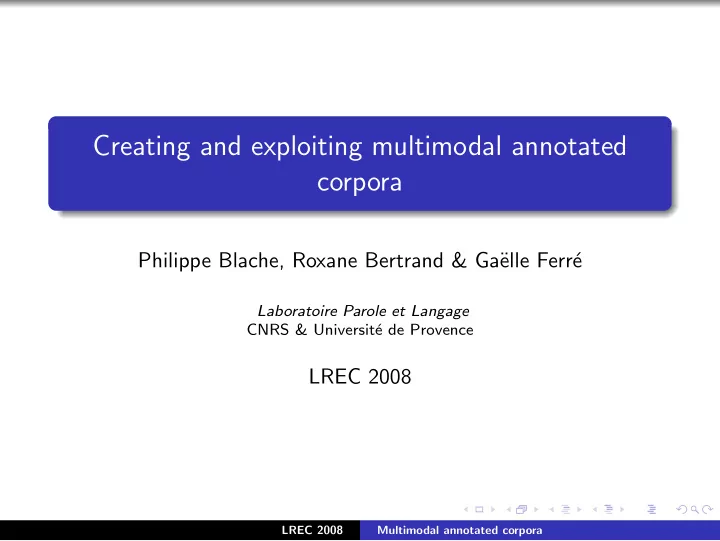

Creating and exploiting multimodal annotated corpora Philippe Blache, Roxane Bertrand & Ga¨ elle Ferr´ e Laboratoire Parole et Langage CNRS & Universit´ e de Provence LREC 2008 LREC 2008 Multimodal annotated corpora
Introduction Multimodality Information comes from different sources Modalities interaction Each source is partial, incomplete They have to be synchronized Multimodal annotation Goals Usually focus on gesture description Mainly in the perspective of communication Conventions and schemes Tools (Praat, Anvil, Elan, etc.) Our project Linguistic description Study of interaction: annotation of all domains Unrestricted data (natural situations) LREC 2008 Multimodal annotated corpora
Outline The project The CID corpus The annotation process Results Backchannels Reinforcing gestures Perspectives LREC 2008 Multimodal annotated corpora
The corpus Corpus of Interactional Data : 8 dialogs, 1 hour each ([Bertrand & al 07]) Transcribed (orthographic, phonetic) Aligned Annotated Prosody (intonation, units, contours, etc.) Morphosyntax, syntax, Discourse (markers, speech turns, etc.) Gestures LREC 2008 Multimodal annotated corpora
The annotation architecture LREC 2008 Multimodal annotated corpora
Signal segmentation Interpausal units segmentation (IPUs) Syntactic units detection (pattern method) LREC 2008 Multimodal annotated corpora
Transcription Precise transcription convention Transcription by 2 experts Enriched orthographic transcription (EOT), needed for different phenomena annotation and alignment (elisions, schwa, etc.) Generation of 2 transcription versions Orthographic (for the NLP module) Phonetic (for speech analysis) LREC 2008 Multimodal annotated corpora
Alignment LREC 2008 Multimodal annotated corpora
Alignment Identifying the phoneme suite Tokenisation Grapheme-phoneme conversion Alignment tool Input: list of phonemes + audio signal Temporal localization of the phonemes in the signal Manual correction Wrong boundaries Overgeneration (false units) Tokens and phonemes are primary levels, used for anchoring other levels LREC 2008 Multimodal annotated corpora
Intonation: INTSINT LREC 2008 Multimodal annotated corpora
Discourse LREC 2008 Multimodal annotated corpora
Gestures LREC 2008 Multimodal annotated corpora
Summary of the tools Fully automatic IPU segmentation Phoneme alignment Intonation POS tagging Semi-automatic Intonational units Shallow parsing (still needs a segmentation tool) Manual Transcription (we are experimented speech recognition as helping tool) Other annotations Tools and resources available from the CRDO (http://crdo.fr/) LREC 2008 Multimodal annotated corpora
First study: Backchannels Backchannels: minimal signal produced by the hearer. Vocal and gestural BCs (head movements, smiles and laughter, eyebrow movements, etc.), they have different functions Example : Question : Do vocal and gestural BCs behave similarly? In what prosodic and morphological contexts do they appear? LREC 2008 Multimodal annotated corpora
Backchannels Vocal and gestural BCs show similar behavior but gestural BCs appear later than vocal ones Morphological and discursive context After nouns, verbs and adverbs (words with semantic function) Not after connectors (linking words between conversational units) Prosodic context Gestural BCs: after accentual phrases (APs) and intonational phrases (IPs) Vocal BCs: after IPs Encouraged by specific contours (esp. rising), speakers gaze Conclusion : BCs occur at the end of some units, but not with possible turn change. They also play a role in the elaboration of discourse. LREC 2008 Multimodal annotated corpora
Second study: Reinforcing gestures Reinforcing gestures: eyebrow movements, gaze direction, head movements, highlighting discourse elements Example : Questions : What do gestures reinforce? Are they equivalent to known focalization phenomena? LREC 2008 Multimodal annotated corpora
Reinforcing gestures: results No correlation with prosodic focalization, no gesture is associated with specific stress or contour Correlation with adverbs and connectors at the beginning of speech turns Correlation for metaphorics, no correlation for eyebrow movements Conclusion Reinforcing gestures do not serve to express focus Their role is more discursive than expressive LREC 2008 Multimodal annotated corpora
Conclusion CID: large corpus, richly annotated Interest of multimodal annotated corpora Study of natural language, in context Study of interaction Problems Standardisation: coding schemes Synchronization of the different domains (+/- temporal) Interfacing the different tools Perspectives Information structure study Description in terms of constructions (CxG) Multimodal interaction for virtual reality LREC 2008 Multimodal annotated corpora
Recommend
More recommend